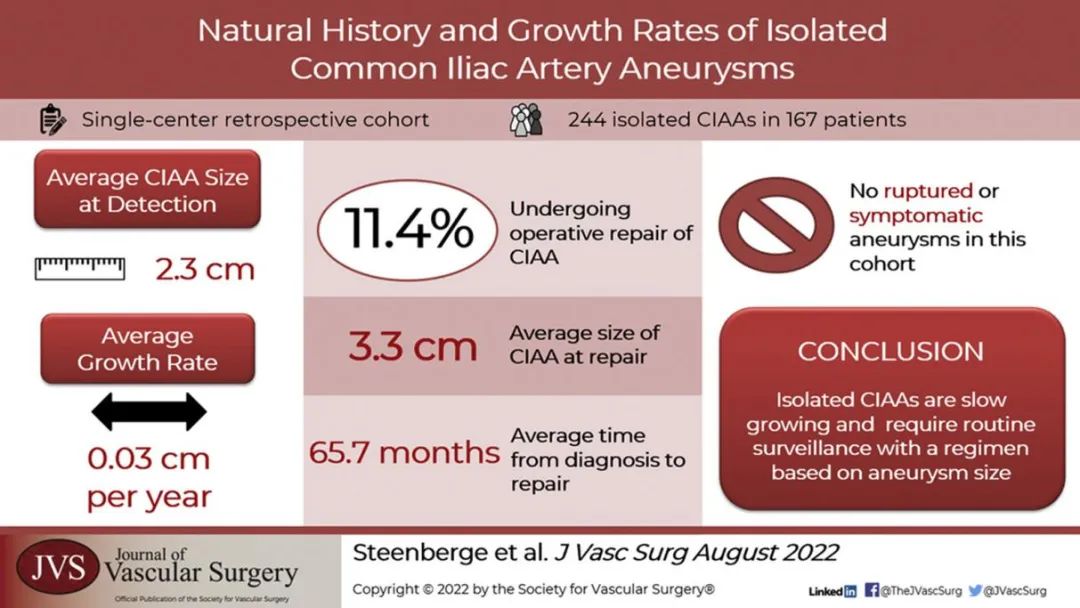
Isolated common iliac artery aneurysms (CIAA) Due to their rarity and uncertainty of progression, there is no consensus in the field of vascular surgery as to when and how to treat these lesions. Traditional treatment strategies are usually based on the size and growth rate of the aneurysm, as well as the risk of rupture. However, recent studies have provided new insights, suggesting that isolated CIAAs are extremely unlikely to rupture at smaller sizes.
At the 50th International Vascular and Endoluminal Vascular Congress (VEITH 2023), November 14-18, US local time, Christopher J. Smolock, M.D., from Mount Sinai Health System, Mount Sinai Queens, USA, presented a study published by his team in the Journal of Vascular Surgery, a study designed to determine the natural course and growth rate of CIAA in order to inform monitoring protocols and adaptive sizing of elective repairs [1].

Background of the study
CIAA is a relatively rare lesion in vascular surgery, accounting for approximately 7% of all abdominal aorto-iliac aneurysms, with approximately 1/3 of CIAA affecting both common iliac arteries.CIAA is usually defined as localized permanent dilatation of the common iliac arteries by at least 50% in relation to normal vessel diameter. Most CIAAs coexist with abdominal aortic aneurysms (AAA), but there is a relative lack of data on the natural course and growth rate of isolated CIAAs. The growth rate of isolated CIAA has been reported in the literature to be approximately 1 to 4 mm per year, and data on the relationship between rupture and size are mainly from case series, with the majority of reported ruptures involving aneurysms larger than 5 cm in diameter, and ruptures of aneurysms smaller than 4 cm have been reported as rare in the literature.
Single-center retrospective study that included isolated CIAA >2 cm diagnosed in a single center between January 1, 2008, and February 29, 2020.Patient demographics, comorbidities, and CIAA procedure details were collected.
DEFINITION OF CIAA: In this study, isolated CIAA was defined as aneurysms ≥2 cm in diameter.
ASSESSMENT METHODS: The growth of CIAA was assessed by ultrasound (US) and computed tomography (CT).
1, Patient and procedure information:
A total of 244 isolated CIAAs in 167 patients from a single center were included in the study.94% of the patients were male, and the mean age at the time of detection of the CIAA was 68.1 yrs.69% were identified by ultrasonography, and the mean diameter of the CIAA was 2.3 cm.Surgical repair of the CIAA was performed in 11.4% of the patients, with a mean diameter of 3.30 cm.The majority of the repairs were performed through endoluminal approaches was performed (73.7%). No symptomatic or ruptured isolated CIAA was identified.In isolated CIAA, 10.6% (26 patients) had aortic diameter dilatation of at least 3 cm, leading to AAA formation. The mean time from CIAA diagnosis to repair was 65.7 months.
2. Isolated CIAA growth rate:
The overall CIAA growth rate was 0.4 mm/year. Subgroup analysis based on CIAA size showed:
(1) CIAA with diameters between 2.0 and 2.49 cm had an annual growth rate of 0.22 mm/year.
(2) The annual growth rate of CIAA with a diameter of 2.5 to 2.99 cm was 0.3 mm/year.
(3) The annual growth rate of CIAA with a diameter greater than or equal to 3 cm is 0.5 mm/year.
3.Recommendations for monitoring frequency:
(1) For isolated CIAA with a diameter of 2.0 to 2.49 cm, monitoring is recommended every 3 years.
(2) For isolated CIAA with a diameter of 2.5 to 2.99 cm, monitoring is recommended every 2 years.
(3) For isolated CIAA with a diameter greater than or equal to 3 cm, annual monitoring is recommended.

summarize
bibliography
Reprinted from Outpatient Magazine


